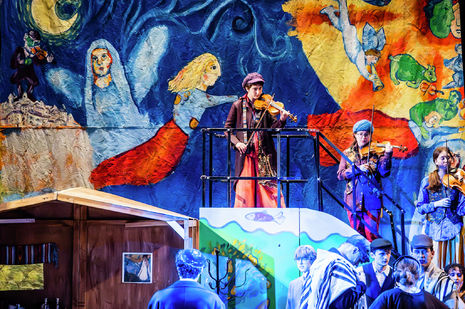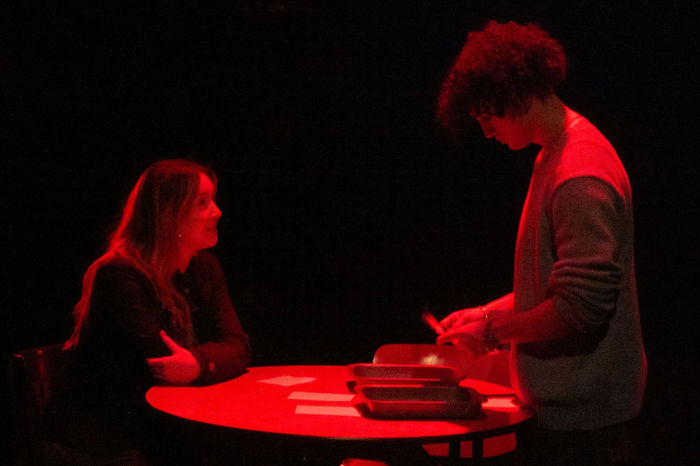Setting the scene
Varsity‘s Theatre team take a look at the unsung heroes of any good Cambridge production

When considering all the creativity poured into a production, our minds may flick back to the contributions of actors, writers, and directors. Yet, the last year in Cambridge theatre has been testament to the impact and importance of set design. Reflecting on a variety of sets, ranging from the grandiose designs of the ADC to the smaller, more intimate examples found in college chapels and the Corpus Playroom, Varsity’s Theatre team consider the standout sets of the academic year, narrowing them down to their favourites below.
“The last year in Cambridge theatre has been testament to the impact and importance of set design”
Skellig – Josh Pritchard
It’s hard to create an ADC set that truly feels unique, but Skellig’s bold and experimental design was undoubtedly one of the most impressive sets I’ve witnessed throughout the year. Separating the front and back of the stage through the use of a gauze drew a striking boundary between the chaos and freneticism of the outside world, and the quiet, nebulous world of the titular character. Director Stan Hunt was clearly unafraid to experiment with levels, using ladders at the side of stage to enhance the whimsical interactions between Abi Beton’s Mina and Alex Thompson’s Michael. This was all heightened by a truly extraordinary, almost cinematic, lighting design, lending ample spectacle and pageantry to a production already blessed with an incredible script and talented cast. That moment where Skellig’s wings rise above the golden stage? A truly iconic CamDram moment.
Stempenyu! – Daisy Bates
I’d be remiss not to mention Stempenyu!, whose beautiful set was both practical and immersive. Incorporating the band into the set by fixing them downstage left made the play’s diegetic music all the more engaging. In the few scenes where the band wasn’t onstage, their seats remained as a reminder of the music that drives the story. That said, it was the backdrop, hand-painted in vivid colour by a team led by Oscar Griffin, that captured my attention. The cloth depicts the story of Stempenyu! through motifs from various Chagall paintings, at once drawing you into and elevating you above the Ukrainian shtetl where the play is set.
Life With Oscar – Kaitlyn Butterly
Less is more when it comes to the set design of Life With Oscar. As a one-man show, it was important that the set didn’t distract from the actor. A coat stand, a bowl of water, a chair, and the centrepiece: the Oscar. All are used throughout the show, each piece seamlessly changing in meaning and importance as the story transitions. Take the Oscar: at first, it remains perched on the coat stand and is only taken down to draw attention to its high value. But as Hollywood becomes increasingly messy and less glamorous, the Oscar becomes a phone, taken down from its pedestal to become a household commodity rather than the highly coveted award. In a world of maximalist set designs, the more minimalist approach allows the characters and story to take precedence, but also allows the props on stage to speak for themselves.
“In the past year, there’s been a real buzz around the various productions being staged in various college chapels”
Everybody’s Talking About Jamie – Kate Woodman
The set of Everybody’s Talking About Jamie was impressive; a testament to the ability and dedication of the technical team. It delivered a polished and professional look, with many features of the set being similar to that of the professional production. The set added considerably to the atmosphere and audience enjoyment of the show. The kitchen set, in particular, was striking in its attention to detail which helped ground the production in reality. The fact it was moved on a track on the stage rather than being pushed on by the backstage crew was effective and slick, and especially commendable in a student show.
Timon of Athens – Millie Wooler
In the past year, there’s been a real buzz around the various (largely Shakespearean) productions being staged in various college chapels. These comparatively sparse but beautiful buildings are taking on new life as theatres. Perhaps the most effective of these conversions was Michaelmas Term’s Timon of Athens in the opulent Trinity Chapel. The contrast between the incredibly intricate architecture and the minimal set created a sense of isolation and exclusion, complimenting the play’s major themes. The transition from the spacious city into the suffocating woods was managed not through a scene change but through a mere lowering of lights, decreasing the space available for the actors to employ, and focusing the audience’s attention on Timon as he scrambled through the dirt pit cut into the projecting stage. Overwhelmingly simple but effective, one could almost imagine themselves in the Blackfriars Theatre.
L’incoronazione di Poppea – Leon Rake
Two sets have stayed with me long after the final curtain. L’incoronazione di Poppea was wild and opulent. A Baroque vision reimagined in the 1980s, the stage was thick with symbolism. Towering pillars framed a huge, haunting portrait of Myriam Lowe as Nero watching over everything. It felt excessive, corrupted and beautiful, just like the story. I couldn’t look away. Then came Sola, and everything fell silent. There was no set and no backdrop, just a bare stage and bodies moving through white light. It was stark and exposed and utterly hypnotic. Nothing distracted. The power came from the performers alone. Every gesture felt deliberate, every movement heavy with meaning. I sat completely still, as if any shift might break the spell. Time seemed to stretch.
 News / East West Rail proposes new Cambridge East station26 November 2025
News / East West Rail proposes new Cambridge East station26 November 2025 News / Uni registers controversial new women’s society28 November 2025
News / Uni registers controversial new women’s society28 November 2025 Comment / Cambridge is woke – that’s no bad thing 28 November 2025
Comment / Cambridge is woke – that’s no bad thing 28 November 2025 News / DfE counter-terror unit contacted Cambridge over PalSoc speaker concerns28 November 2025
News / DfE counter-terror unit contacted Cambridge over PalSoc speaker concerns28 November 2025 Music / Spotify unwrapped: 2025 predictions28 November 2025
Music / Spotify unwrapped: 2025 predictions28 November 2025









